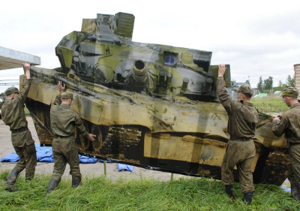Odds and endsRussia's inflatable military
Russia is building inflatable weapons which, to an enemy radar or satellite imagery, appear like real weapons; they are easy to transport and quick to deploy — and they cost far less to produce then real weapons

Positioning the armor // Source: blogspot.com
During the 1948-49 Arab-Israeli war (the Israelis call it War of Independence), the poorly equipped Israeli forces found a way to compensate for their inferior weapons and small numbers relative to the attacking Arab armies. In two theaters of the war, Safed and Jerusalem, they employed a homemade mortar called Davidka.
The Davidka’s shells exploded with a tremendous, ear-splitting noise, but were otherwise of little military value. The Davidka was thus used not for its tactical value, but for its psychological effect: the shells, due to their extreme noise and horrific explosions, proved particularly useful in scaring away Arab forces, despite the fact that they were very inaccurate.
Now the BBC reports that the Russian military has also come up with a clever way to deceive the enemy and save money at the same time: inflatable weapons.
These weapons have three advantages over real weapons: they look just like real ones so they create the same effect on an observer, but they are easy to transport and quick to deploy — and they cost far less to produce.
The Russians have created inflatable decoys for many of their weapon systems: tanks, S-300 rocket launchers complete with giant truck and inflatable rockets; MiG fighter jets; even entire Russian radar stations.
The BBC notes that these state-of-the-art stand-ins are among the most advanced military decoys in the world.
What they lack in firepower, they make up for in flexibility: they are light and can be deployed quickly to deceive the enemy. They are also very realistic. They are made of a special material that tricks enemy radar and thermal imaging into thinking they are real weapons.
The inflatable weapons are stitched together at a former hot-air balloon factory.
